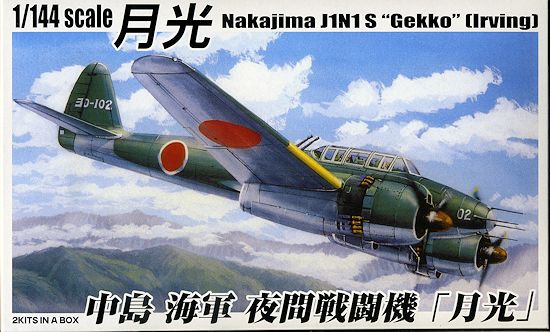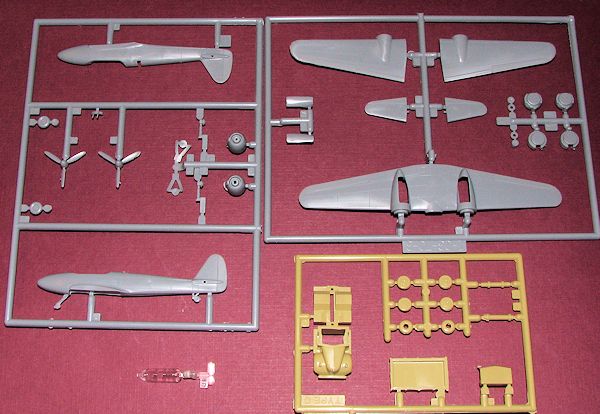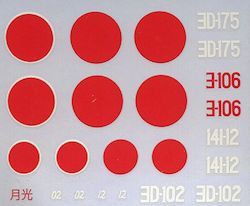
| KIT #: | 033159 |
| PRICE: | $16.00 SRP |
| DECALS: | Four options |
| REVIEWER: | Scott Van Aken |
| NOTES: | Rebox of Hasegawa kit? |

| HISTORY |
In mid-1938 the Japanese Imperial Navy requested a twin-engine fighter designed to escort the principal bomber used at the time, Mitsubishi G3M "Nell". The operating range of the standard Navy fighter, the Mitsubishi A5M "Claude", was only 1,200 km (750 mi), insufficient compared with the 4,400 km (2,730 mi) of the G3M. Moreover, at the time, the potential of the "Zero", then still under development, remained to be evaluated, stressing the need for a long-range escort fighter.
In March 1939, Mitsubishi and Nakajima began the development of a project 13-Shi. The prototype left the factory in March 1941 equipped with two 843 kW (1,130 hp) Nakajima Sakae 21/22, 14-cylinder radial engines. There was a crew of three, and the aircraft was armed with a 20 mm Type 99 cannon and six 7.7 mm (.303 in) Type 97 machine guns. Four of these machine guns were mounted in a powered turret, the weight of which reduced the performance of the aircraft considerably. Because of the sluggish handling, being used as an escort fighter had to be abandoned. Instead, production was authorized for a lighter reconnaissance variant, the J1N1-C, also known by the Navy designation Navy Type 2 Reconnaissance Plane. One early variant, the J1N1-F, had a spherical turret with one 20 mm Type 99 Model 1 cannon mounted immediately behind the pilot.
In 1943, Commander Yasuna Kozono(小園 安名) of the 251st Kokutai in Rabaul came up with the idea of installing 20 mm cannons at 30 degree angle in the fuselage. Against orders of central command which was skeptical of his idea, he tested his idea on a J1N1-C as a night fighter. The field-modified J1N1-C KAI shot down two B-17s of 43rd Bomb Group attacking air bases around Rabaul on 21 May 1943.
The Navy took immediate notice and placed orders with Nakajima for the newly designated J1N1-S night fighter design. This model was christened the Model 11 Gekko (月光, "Moonlight"). It required only two crew and like the KAI, had a twin 20 mm pair of Type 99 Model 1 cannon firing upward in a 30° upward angle and a second pair firing downward at a forward 30° angle, placed in the fuselage behind the cabin, similar to the German Schräge Musik configuration, but also in a ventral mode—the original German Schräge Musik mount was strictly upward-firing only. Development of both Japanese and German night fighters were independent of each other. This arrangement was effective against B-17 Flying Fortress bombers and B-24 Liberators, and its existence was not quickly understood by the allies who assumed the Japanese did not have the technology for night fighter designs. Early versions had nose searchlights in place of radar. Later models omitted the two lower-firing guns and added one 20 mm cannon to face upward as with the other two (J1N1-Sa Model 11a). Other variants without nose antennae or searchlight added a 20 mm cannon to the nose.
The J1N1-S was used against B-29 Superfortresses in Japan, though the lack of good radar and insufficient high-altitude performance handicapped it, since usually only one pass could be made against the higher-speed B-29s. However, some skillful pilots had spectacular successes, such as Lieutenant Sachio Endo, who was credited with destroying eight B-29s and damaging another eight before he was shot down by a B-29 crew, Shigetoshi Kudo (nine victories), Shiro Kuratori (six victories), and Juzo Kuramoto (eight victories); the last two claimed five B-29s during the night of 25–26 May 1945. Another Gekko crew shot down five B-29's in one night, but these successes were rare. Many Gekkos were also shot down or destroyed on the ground. A number of Gekkos were relegated to "Tokko" missions, the Japanese term for kamikaze attacks, using 250 kg (550 lb) bombs attached to the wings.
| THE KIT |
 This is a
rather basic kit that is either a reissue or a rebox. I can recall purchasing
this same kit with a revetment in a Hasegawa box back in the early 1980s so it
may be that it is a Hasegawa designed molding. The kit includes two complete
aircraft each of which comes with a small truck that was part of the diorama of
the Hasegawa boxing. In fact, the back page of the instructions shows this
diorama setting. The kit looks to be pretty accurate and not a caricature of the
plane as was often the case with 1/144 military models prior to this one.
This is a
rather basic kit that is either a reissue or a rebox. I can recall purchasing
this same kit with a revetment in a Hasegawa box back in the early 1980s so it
may be that it is a Hasegawa designed molding. The kit includes two complete
aircraft each of which comes with a small truck that was part of the diorama of
the Hasegawa boxing. In fact, the back page of the instructions shows this
diorama setting. The kit looks to be pretty accurate and not a caricature of the
plane as was often the case with 1/144 military models prior to this one.
There is no cockpit and some of the fine parts shown on the box art, such as the radar array, is not included. The molds have some flash and it is especially noticeable on the lower fuselage pitot boom. Two different sets of cowlings are supplied, one for this kit and another not to be used that includes the long upper nacelle exhaust.
The upper guns are an insert that fits behind the cockpit. Each of the main gear legs is a single piece with a hefty mounting post. Separate main wheels and gear doors are included. There is no wheel well detail. The tail wheel is molded onto one fuselage half. There is no engine detail and little would be seen if there was. The one-piece props and spinners are nicely molded as is the one-piece canopy.
The truck that comes with the kit is pretty much as simple as the kit with a body/cab assembly, the flat bed and roof as separate bits. There are two hefty axles and six tires to complete the truck. This was also available in other kits as a starter truck, fuel truck and as a covered bed version, hence the somewhat modular build. No windows are included.
 Markings
are for four planes, though the instructions, being totally in Japanese, do not
give your editor much of an idea of exactly how they are painted or the units.
Fortunately, I have been around a while and can tell you that two are from the
Yokosuka Naval Group with the ƎD tail code. I am not sure
what the red tail codes are for as the majority of these planes were either an
overall Dark Green or Dark Green over Light Grey. Perhaps the red coded plane
was unpainted metal. The decal sheet is nicely printed and gives Hinomarus with
and without the white surround for the upper surface and sides. Again, no clue
as to which uses what aside from the box art plane. Incidentally, the box art is
identical to that used on the Hasegawa boxings of 30 years back.
Markings
are for four planes, though the instructions, being totally in Japanese, do not
give your editor much of an idea of exactly how they are painted or the units.
Fortunately, I have been around a while and can tell you that two are from the
Yokosuka Naval Group with the ƎD tail code. I am not sure
what the red tail codes are for as the majority of these planes were either an
overall Dark Green or Dark Green over Light Grey. Perhaps the red coded plane
was unpainted metal. The decal sheet is nicely printed and gives Hinomarus with
and without the white surround for the upper surface and sides. Again, no clue
as to which uses what aside from the box art plane. Incidentally, the box art is
identical to that used on the Hasegawa boxings of 30 years back.
| CONCLUSIONS |
It is nice to see this one returning to the market. Apparently the whole batch has been reissued, save for perhaps the Ki-21 which I have not seen in the reissue listings. These are really not bad kits and though not up to modern standards, are still nicely done with fine engraved markings and worthy of anyone's display shelves.
| REFERENCES |
http://en.wikipedia.org/wiki/Nakajima_J1N
February 2013 Thanks to www.dragonmodelsusa.com
for the preview kit. You can find this one at your favorite hobby shop
or on-line at
www.testors.com If you would like your product reviewed fairly and fairly quickly, please
contact
the editor or see other details in the
Note to
Contributors.